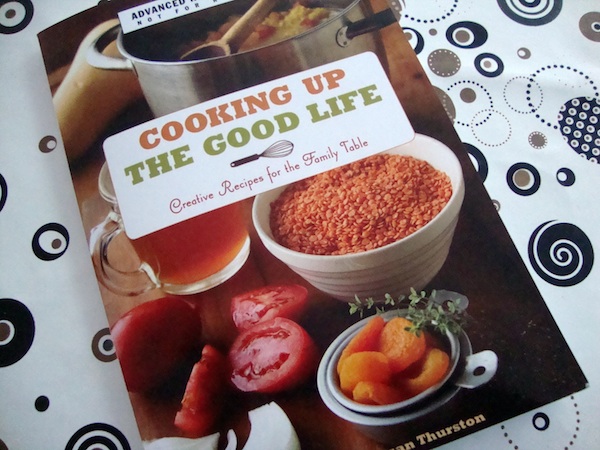
If I ever need to feed a commune, this is a book I want by my side. The recipes in Cooking Up the Good Life: Creative Recipes for the Family Table pack in plenty of nutrition from inexpensive ingredients — and they do it in quantities that defy my definition of nuclear family and are starting to strain my freezer space.
Chef Jenny Breen and writer Susan Thurston, both Minnesotans, take the value of eating sustainably as their starting point; they assume the reader doesn’t need a lot of convincing to buy local vegetables in season and substitute beans and whole grains for animal protein. Thurston’s introduction interweaves the history of Minnesota’s local food movement with Breen’s own story. She cooked at the Seward Cafe for seven years before starting her own catering business and restaurant. (The book takes its title from her Good Life Catering.) Among roughly 140 recipes, perhaps a dozen involve dead animals, and most of the rest are vegan, as well. The ingredients, with a few exceptions, all grow here in the Upper Midwest.
The subtitle, “Creative Recipes for the Family Table,” comes into play in short tips for getting kids involved in the kitchen. Some of these may seem obvious to parents who are used to having little ones hanging around in the kitchen — kids can shape croquettes into patties or cut polenta with cookie cutters — but for cooks who are used to going it solo, these small encouragements that, yes, children can be safe and useful in an environment filled with knives and fire are certainly useful. (Other tips are just useless. “Kids love soup.” Hah! Let me introduce you to my children.)
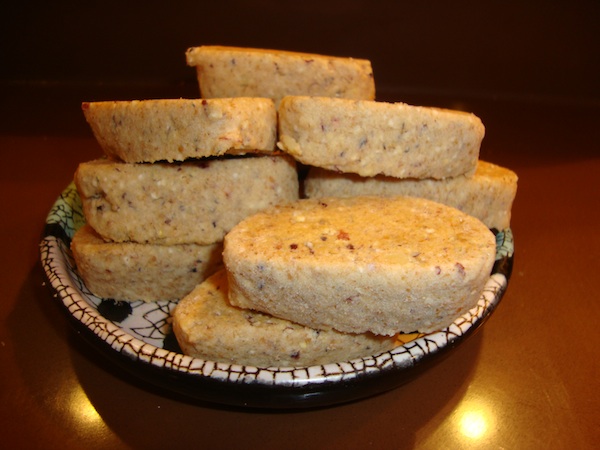
As for the recipes, let’s have dessert first: The Cornmeal-Walnut Shortbread will definitely become part of my repertoire. (Especially for bake sales. While the recipe claims to make two dozen, it calls for a full pound of butter and I easily got 50 good-size shortbread cookies out of it.) These are grown-up treats, with the flavor of the cornmeal right at the forefront and very subtly sweet. I used a coarsely ground heirloom variety, but I imagine even the bright yellow stuff in the blue canister would make a sophisticated cookie and I plan to give it a try very soon.
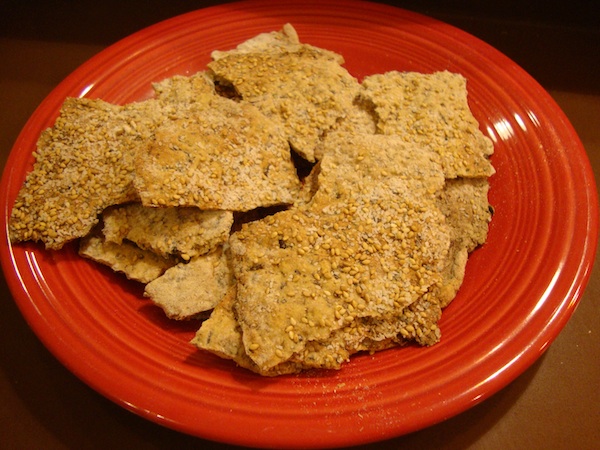
I’m also definitely going to make the Wild Rice Crackers again. With whole wheat flour, cornmeal, and cooked wild rice, these are packed with flavor and fun to serve. Unfortunately, I had to modify the recipe to make it work. The instructions say to roll out the dough to ¼-inch thick and bake at 400 degrees. That’s a good way to make rubbery flatbread. But with the oven at 450 and the dough rolled out nearly paper thin, the crackers turned out crisp and delicious.

Among the starters, I tried the Polenta with Tomato Jam, which I’ll call half a keeper. The authors recommend using cornmeal grown and ground by Greg Reynolds of Riverbend Farm in Delano. He grows a mixture of heirloom varieties, including Mandan bride, and it is truly a local wonder: nutty, rich, flecked with blue and red. Sadly, you can’t buy it in stores (through sheer good fortune, a precious bag of it showed up in my CSA box once) and you can’t cook it according to the instructions in the recipe. Raw cornmeal needs to cook for 45 minutes to an hour, with near constant stirring. The recipe is written for instant polenta, which cooks in five minutes or less. But, let’s assume the polenta shapes, which you can make however you feel comfortable, are just a vehicle for the real star of the show, the tomato jam. While it never sets up like a jam, it is tasty. Maple syrup plays against the jalapenos and garlic, and the ginger makes sure this will never be mistaken for just a thick tomato sauce. Like other recipes I tried, however, it needed just a little more kick. Next time, I think I’ll up the ginger.
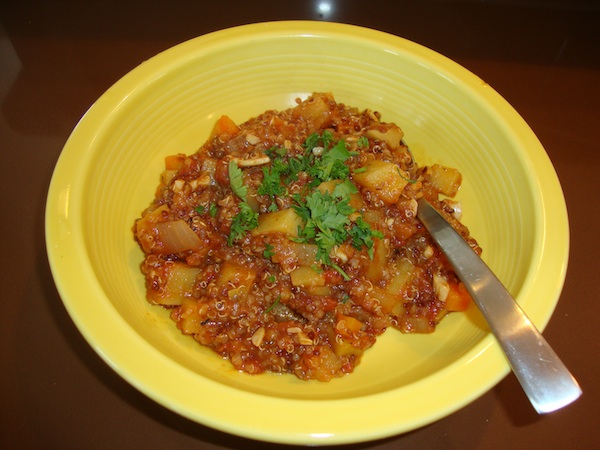
Now, about that commune. There are a lot of stereotypes about vegetarian food out there, and a few of the recipes in this book play into them. Let’s take the Cashew-Quinoa “Chili.” (First, “Serves 6–8”? Yeah, maybe six to eight organic farmhands. I’m going to have leftovers for weeks.) I chopped and sautéed and stirred in spices and in the end, I had a massive pot of largely undifferentiated mush. The cashews, clearly meant to alleviate that, seemed like an afterthought. The flavor of the quinoa got totally lost, becoming nothing but filler. I felt a little sad bringing it to the table. I wanted some pizzazz. Some texture. A little more heat. Less cumin. (Cumin, to me, is the stereotypical vegetarian spice.) My guests, however, loved it. Had seconds. Asked to bring some home with them. Wrote emails the next day about how much they enjoyed the leftovers. While I do have some exceptionally polite friends, I think I actually have to give Breen and Thurston and their chili credit here. For many people, this chili will certainly be a big pot of comfort food.
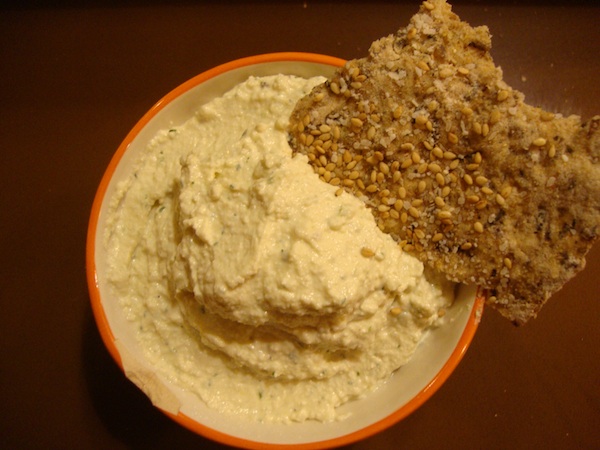
The other big vegetarian stereotype, tofu, does put in a few appearances, but it certainly doesn’t dominate the book. I tried the Dilled Veggie Pate — more a dip than a pate and one of nine pate recipes in the book. It involves whirring two pounds — for real, how big are these families? — of tofu in the food processor with garlic and spices. Ridiculously simple. And surprisingly tasty. The lactose intolerant in my family put in a request for this as a regular cream cheese replacement. (Even so, the four of us did not manage to use up the five cups of dip before it finally went bad.)
I’m not done with Cooking Up the Good Life just yet. I’ve got my eye on the Wild Rice Croquettes, the Wild Mushroom Stroganoff, and the Barley Risotto. I admire Breen and Thurston for the “family tables” they manage to set, full of nourishing, simple food, even if my own little family isn’t gobbling up, say, Curried Chickpeas with Autumn Vegetables. But the next time I have to cook for a crowd, this is definitely one book I’ll reach for.
Cooking Up the Good Life: Creative Recipes for the Family Table
By Jenny Breen and Susan Thurston
Published by the University of Minnesota Press, April 2011
200 pages, $19.95

Hi Tricia
thanks so much for the great review, and wonderful pictures. I really appreciate all the great feedback and thoughts on the recipes! I do have a clarification that I think is somewhat important regarding the polenta recipe. I wanted to make sure that people understand that the recipes for polenta are not recipes for instant polenta, but are recipes that use fresh polenta or cornmeal. I know we have all learned that we need to cook polenta for a long time, but I have been making it this way (in about 10 minutes) for years, and find that the texture and flavor are great-hearty, and flavorful-so please make sure that your readers understand that no mistake was made….they are meant to be prepared as described and are quite delightful this way. Thanks again
Jenny Breen
Well, shoot, Jenny! Thanks for the clarification. Normally when I review a cookbook I follow the directions to the letter, no matter what my cooking prejudices say, but this time I violated my own rule. And I would have learned something if I hadn’t. Next time I make polenta, I’ll try it your way, instead of cooking the hell out of it. Congrats to you and Susan on a great book!